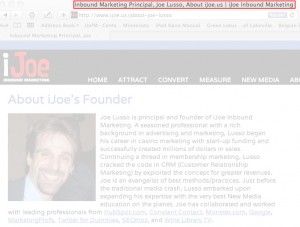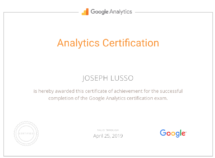There are a number of best practices to optimize your website. This blog article will focus on one very impactful method known as the title tag. Focus your energy on the title tags to get found online. This is a powerful and intimate exercise. Its a great first step in improving your website’s findability by Google, Yahoo and Bing.
Title tags are text that appear in the top line of a user’s web browser. Safari is a great browser to see these tags visually displayed (see screen shot). They appear in every browser but Safari displays a nice clean view across the very top. These are the keywords describing the content related to your web page.
Think about crafting these keywords as advertising text. The url, title tag and alt text (naming graphics/images) correlate very well with high search performance.
Many search pros believe the title tags are the only HTML meta tags on our website that search engines crawl to find your website online. There are 3 main tags but for purposes of this blog, we will focus on title tags. HTML title tags are not a meta tag, but it’s worth discussing in relation to them.
For impact, lets focus on what Google practices in search.
Title tags can only display up to 70 characters in your browser. It is recommended to keep your title tags under 70 characters. In addition, much of the research points to placing your most descriptive keyword/phrase to describe your page as far forward in the string of 70 characters as possible. If your page is touting ‘website results,’ make sure it’s the first phrase in the 70-character string.
Page titles tell visitors what a page is about. From a Search Engine Optimization (SEO) perspective, it is good to keep your page titles concise. If your page title is too long, it will dilute the importance of each term in the title. This might prevent you from ranking well on any of the words in your page title.
Come up with a concise but keyword-rich description of your page. Make that your page title. Choosing long-tail phrases are an effective solution. Long-tail keywords are more specific and target less competitive niche markets instead of highly competitive broad keywords. Long-tail phrases containing commonly used words may significantly improve a website’s search ranking.
Your company name should not be the start of the page title. The first few words in a page title are the most influential in search engine results. You want people that don’t know about your brand to be able to find you, so using more general industry keywords is important.
Use three methods to understand your customers’ perception of your products or services: web analytics, customer survey, and competitors’ content.
After compiling a keyword glossary from research, narrow your selection based on four criteria: category, popularity, competition, and relevance.
Now, find the middle. It is important to find words that both uniquely describe your company’s services and are commonly used.
If I had to start in one place to increase my presence online, it would be with my website’s title tags.
There are two online training videos available to successfully walk you through this process. Navigate to Crash Course in SEO and Advanced SEO Tactics.

Example of Title Tags from iJoe.us About Page.


